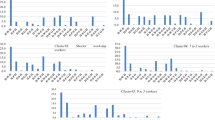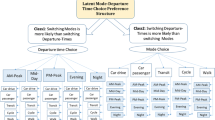Abstract
This study analyzes the annual vacation destination choices and related time allocation patterns of American households. More specifically, an annual vacation destination choice and time allocation model is formulated to simultaneously predict the different vacation destinations that a household visits in a year, and the time (no. of days) it allocates to each of the visited destinations. The model takes the form of a multiple discrete–continuous extreme value (MDCEV) structure. Further, a variant of the MDCEV model is proposed to reduce the prediction of unrealistically small amounts of vacation time allocation to the chosen destinations. To do so, the continuously non-linear utility functional form in the MDCEV framework is replaced with a combination of a linear and non-linear form. The empirical analysis was performed using the 1995 American Travel Survey data, with the United States divided into 210 alternative destinations. The model estimation results provide several insights into the determinants of households’ vacation destination choice and time allocation patterns. Results suggest that travel times and travel costs to the destinations, and lodging costs, leisure activity opportunities (measured by employment in the leisure industry), length of coastline, and weather conditions at the destinations influence households’ destination choices for vacations. The annual vacation destination choice model developed in this study can be incorporated into a larger national travel modeling framework for predicting the national-level, origin–destination flows for vacation travel.



Similar content being viewed by others
References
Ashiabor, S., Baik, H., Trani, A.: Logit models for forecasting nationwide intercity travel demand in the United States. Transp. Res. Rec.: J. Transp. Res. Board 1, 1–12 (2007)
Baik, H., Trani, A., Hinze, N., Ashiabor, S., Seshadri, A.: Forecasting model for air taxi, commercial airline, and automobile demand in the United States. J. Transp. Res. Record 2052, 9–20 (2008)
Beser, M., Algers, S.: The SAMPERS models. In: Lundqvist, L., Mattsson, L.G. (eds.) National Transport Models: Recent Developments and Prospects. The Swedish Transport and Communications Research Board, Stockholm (1999)
Bhat, C.: The multiple discrete-continuous extreme value (MDCEV) model: role of utility function parameters, identification considerations, and model extensions. Transp. Res. B 42(3), 274–303 (2008)
Bureau of Economic Analysis: Gross Domestic Product by State (1995). Retrieved January 10, 2011, from http://www.bea.gov/regional/gsp/
Bureau of Labor Statistics: BLS Spotlight on Statistics Travel (2010)
Bureau of Labor Statistics: Employment, Hours, and Earnings—State and Metro Area (1995). Retrieved December 2010, from http://www.bls.gov/data/#employment
Bureau of Transportation Statistics: 1995 American Travel Survey Technical Documentation. Washington, DC, (1995a)
Bureau of Transportation Statistics: 1995 American Travel Survey Profile (1997). http://www.bts.gov/publications/1995_american_travel_survey/us_profile/entire.pdf
Bureau of Transportation Statistics: Airline Origin and Destination Survey (DB1B). Washington, DC (1995b)
Bureau of Transportation Statistics: Transportation Statistics Annual Report 1998 Long-Distance Travel And Freight. Washington, DC (1998)
Daly, A.: Estimating choice models containing attraction variables. Transp. Res. B 16(1), 5–15 (1982)
Energy Information Administration: Retail Gasoline Historical Prices (1995). Retrieved December 2010, from http://www.eia.doe.gov/oil_gas/petroleum/data_publications/wrgp/mogas_history.html
Epstein, J.M., Parker, J., Cummings, D., Hammond, R.A.: Coupled contagion dynamics of fear and disease: mathematical and computational explorations. PLoS ONE 3(12), 3955 (2008)
Eugenio-Martin, J.: Modelling determinants of tourism demand as a five stage process: A discrete choice methodological approach. Tour. Hosp. Res. 4(4), 341 (2003)
Eymann, A., Ronning, G.: Microeconometric models of tourists’ destination choice. Reg. Sci. Urb. Econ. 27(6), 735–761 (1997)
Fosgerau, M.: PETRA—an activity based approach to travel demand analysis. In: Lundqvist, L., Mattsson, L.G. (eds.) National Transport Models: Recent Developments and Prospects. The Swedish Transport and Communications Research Board, Stockholm (2001)
Greenridge, K.: Forecasting Tourism Demand: An STM Approach. Ann. Tour. Res. 28(1), 98–112 (2001)
Grush, W.: Usage and Vehicle Miles of Travel (VMT) Per Capita. Highw. Inf. Q. 5(4) (1998)
Hackney, J.: Discrete choice models for long-distance travel based on the DATELINE survey. Paper presented at the 4th Swiss Transport Research Conference, Monte Verita/Ascona, 2004
Haliciolgu, F.: An econometric analysis of aggregate outbound tourism demand of Turkey. Paper presented at the 6th DeHaan tourism management conference proceedings, 2008
HCG and TOI: A Model System to Predict Fuel Use and Emissions from Private Travel in Norway from 1985 to 2025: Norwegian Ministry of Transport (1990)
Horowitz, A.: NCHRP Synthesis 358: Statewide Travel Forecasting Models. Transportation Research Board of the National Academies, Washington, DC (2006)
Inter University Consortium for Political and Social Research (ICPSR): 1995 Consumer Expenditure Survey (2011). Retrieved 2011, from http://www.icpsr.umich.edu
Iso-Ahola, S.: Towards a Social Psychology of Recreational Travel. Leis. Stud. 2, 45–56 (1983)
Koppelman, F., Sethi, V.: Incorporating variance and covariance heterogeneity in the generalized nested logit model: an application to modeling long distance travel choice behavior. Transp. Res. B 39(9), 825–853 (2005)
LaMondia, J., Snell, T., Bhat, C.: Traveler Behavior and Values Analysis in the Context of Vacation Destination and Travel Mode Choices: A European Union Case Study (2009)
LaMondia, J., Bhat, C., Hensher, D.: An annual time use model for domestic vacation travel. J. Choice Model. 1(1), 70 (2008)
Lue, C., Crompton, J., Fesenmaier, D.: Conceptualization of multi-destination pleasure trips. Ann. Tour. Res. 20(2), 289–301 (1993)
Lundqvist, L., Mattsson, L.G.: National Transport Models: Recent Developments and Prospects. Springer, New York (2002)
Microsoft: MapPoint North America (2009)
Moeckel, R., Donnelly, R.: nationwide estimate for long distance travel (NELDT) Paper presented at the third international conference on innovations in travel modeling (ITM) of the transportation research board, Tempe, AZ, 2010
Morley, C.L.: A microeconomic theory of international tourism demand. Ann. Tour. Res. 19, 250–267 (1992)
National Oceanic and Atmospheric Administration: Ocean and Coastal Resource Management (2011). Retrieved January 10, 2011, from National Oceanic and Atmospheric Administration http://coastalmanagement.noaa.gov/
Outwater, M.L., Tierney, K., Bradley, M., Sall, E., Kuppam, A., Modugula, V.: California statewide model for high-speed rail. J. Choice Model. 3(1), 58 (2010)
Phaneuf, D.J., Smith, V.K.: Recreation Demand Models. In: Vincent, J.R. (ed.) Handbook of Enviornmental Economics. North Holland, Amsterdam (2005)
Pinjari, A., Bhat, C.: An efficient forecasting procedure for Kuhn-Tucker consumer demand model systems. Technical paper. Department of Civil & Environmental Engineering, University of South Florida (2010)
Pollak, R.A., Wales, T.J.: Demand System Specification and Estimation. Oxford University Press, Oxford (1992)
Rich, J., Brocker, J., Hanson, C., Korchenewych, A., Nielsen, O., Vuk, G.: Report on Scenario, Traffic Forecast and Analysis of Traffic on the TEN-T, Taking into Consideration the External Dimension of the Union-Trans Tools version 2 (2009)
Rugg, D.: The choice of journey destination: A theoretical and empirical analysis. Rev. Econ. Stat. 55(1), 64–72 (1973)
Savageau, D., Loftus, G.: Places Rated Almanac: Macmillan General Reference (1997)
Seddighi, H., Theocharous, A.: A model of tourism destination choice. A theoretical and empirical analysis. Tourism Management 23, 475–487 (2002)
Simma, A., Schlich, R., Axhausen, K.: Destination Choice Modelling of Leisure Trips: The Case of Switzerland. Arbeitsberichte Verkehrs-und Raumplanung, 99 (2001)
U.S. Census Bureau: Demographic profiles: 100-Percent and Sample Data . (2000). http://www.census.gov/census2000/demoprofiles.html
van Middelkoop, M., Borgers, A., Timmermans, H.: Merlin: microsimulation system for predicting leisure activity travel patterns. Transp. Res. Rec. 1894, 20–27 (2004)
Van Nostrand, C.: A Discrete-Continuous Modeling Framework for Long-Distance, Leisure Travel Demand Analysis. Master’s Degree in Civil Engineering, University of South Florida, Tampa, 2011
VisitUSA.com: State Hotel Guide (2011) http://www.visitusa.com/state-hotels/index.htm
Vortish, P., Wabmuth, V.: VALIDATE—A nationwide dynamic travel demand model for Germany. Paper Presented at the Transportation Research Board Planning Applications Conference, Daytona, FL, 2007
Winwaed Software Technology: Mile Charter (Version 2.12) (2009)
Woodside, A., Lysonski, S.: A general model of traveler destination choice. J. Trav. Res. 27(4), 8–14 (1989)
Yao, E., Morikawa, T.: A Study on Intercity Travel Demand Model. Paper Presented at the 10th conference on travel behavior research Lucerne (2003)
Zhang, L.: Multimodal inter-regional origin-destination demand estimation: A review of methodologies and their applicability to national-level passenger travel analysis in the U.S. Paper Presented at the 2010 World Conference on Transport Research, Lisbon (2010)
Acknowledgments
The authors would like to thank three anonymous reviewers and the US Co-Editor David T. Hartgen for valuable comments on an earlier version of the paper. Jeff Hood raised (at a conference) thought provoking questions related to overprediction of very short time allocations.
Author information
Authors and Affiliations
Corresponding author
Rights and permissions
About this article
Cite this article
Van Nostrand, C., Sivaraman, V. & Pinjari, A.R. Analysis of long-distance vacation travel demand in the United States: a multiple discrete–continuous choice framework. Transportation 40, 151–171 (2013). https://doi.org/10.1007/s11116-012-9397-6
Published:
Issue Date:
DOI: https://doi.org/10.1007/s11116-012-9397-6




